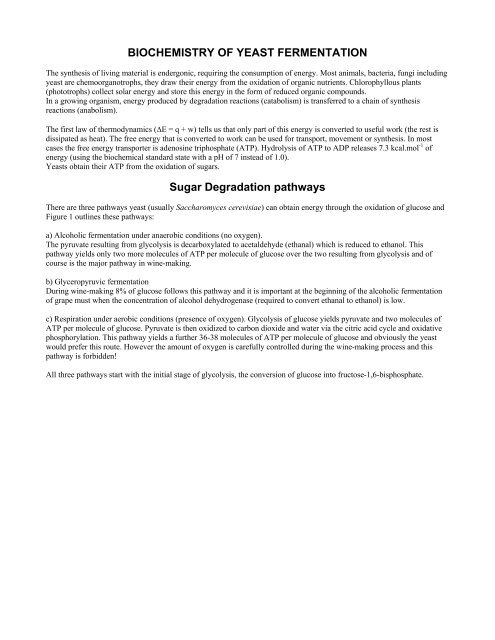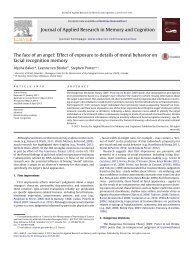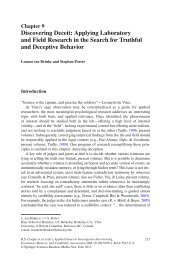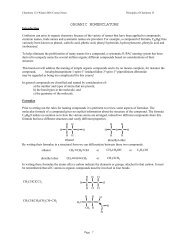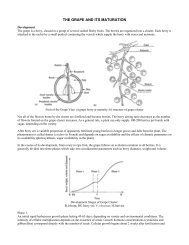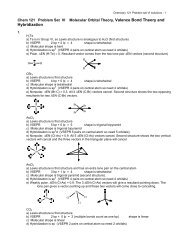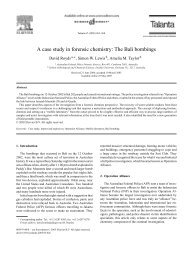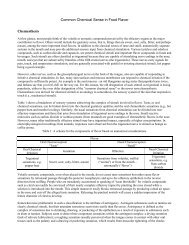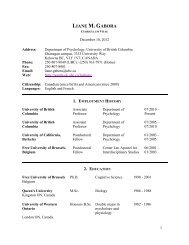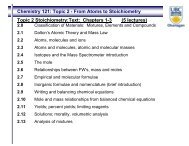BIOCHEMISTRY OF YEAST FERMENTATION Sugar ... - People
BIOCHEMISTRY OF YEAST FERMENTATION Sugar ... - People
BIOCHEMISTRY OF YEAST FERMENTATION Sugar ... - People
You also want an ePaper? Increase the reach of your titles
YUMPU automatically turns print PDFs into web optimized ePapers that Google loves.
<strong>BIOCHEMISTRY</strong> <strong>OF</strong> <strong>YEAST</strong> <strong>FERMENTATION</strong><br />
The synthesis of living material is endergonic, requiring the consumption of energy. Most animals, bacteria, fungi including<br />
yeast are chemoorganotrophs, they draw their energy from the oxidation of organic nutrients. Chlorophyllous plants<br />
(phototrophs) collect solar energy and store this energy in the form of reduced organic compounds.<br />
In a growing organism, energy produced by degradation reactions (catabolism) is transferred to a chain of synthesis<br />
reactions (anabolism).<br />
The first law of thermodynamics (∆E = q + w) tells us that only part of this energy is converted to useful work (the rest is<br />
dissipated as heat). The free energy that is converted to work can be used for transport, movement or synthesis. In most<br />
cases the free energy transporter is adenosine triphosphate (ATP). Hydrolysis of ATP to ADP releases 7.3 kcal.mol -1 of<br />
energy (using the biochemical standard state with a pH of 7 instead of 1.0).<br />
Yeasts obtain their ATP from the oxidation of sugars.<br />
<strong>Sugar</strong> Degradation pathways<br />
There are three pathways yeast (usually Saccharomyces cerevisiae) can obtain energy through the oxidation of glucose and<br />
Figure 1 outlines these pathways:<br />
a) Alcoholic fermentation under anaerobic conditions (no oxygen).<br />
The pyruvate resulting from glycolysis is decarboxylated to acetaldehyde (ethanal) which is reduced to ethanol. This<br />
pathway yields only two more molecules of ATP per molecule of glucose over the two resulting from glycolysis and of<br />
course is the major pathway in wine-making.<br />
b) Glyceropyruvic fermentation<br />
During wine-making 8% of glucose follows this pathway and it is important at the beginning of the alcoholic fermentation<br />
of grape must when the concentration of alcohol dehydrogenase (required to convert ethanal to ethanol) is low.<br />
c) Respiration under aerobic conditions (presence of oxygen). Glycolysis of glucose yields pyruvate and two molecules of<br />
ATP per molecule of glucose. Pyruvate is then oxidized to carbon dioxide and water via the citric acid cycle and oxidative<br />
phosphorylation. This pathway yields a further 36-38 molecules of ATP per molecule of glucose and obviously the yeast<br />
would prefer this route. However the amount of oxygen is carefully controlled during the wine-making process and this<br />
pathway is forbidden!<br />
All three pathways start with the initial stage of glycolysis, the conversion of glucose into fructose-1,6-bisphosphate.
Glycolysis<br />
This series of reactions transforms glucose into pyruvate with the formation of 2 molecules of ATP.<br />
Hexose (glucose) is transported across the plasmic membrane into the cytosol of the cell moving with the concentration<br />
gradient (concentrated outer medium to dilute inner medium).<br />
The first stage of glycolysis converts glucose into fructose-1,6-bisphosphate and requires two molecules of ATP, see Figure<br />
2. Glycolysis is covered in Organic Chemistry, Bruice (3 rd Edition) page 995.<br />
O<br />
O<br />
P<br />
O<br />
HO<br />
O<br />
HOH 2 C<br />
HO<br />
Glycolysis: Glucose to Fructose-1,6-bisphosphate<br />
OH<br />
Glucose<br />
O<br />
O<br />
OH<br />
OH<br />
H<br />
Fructose-1,6-bisphosphate<br />
OH<br />
OH<br />
O<br />
O P<br />
O<br />
O<br />
ATP ADP<br />
ADP<br />
hexokinase<br />
ATP<br />
phosphofructokinase-1<br />
Figure 2<br />
O<br />
O<br />
O<br />
P<br />
O<br />
HO<br />
O<br />
P<br />
O<br />
O<br />
HO<br />
OH<br />
O<br />
OH<br />
H<br />
Glucose-6-phosphate<br />
O<br />
OH<br />
phosphoglucoisomerase<br />
O<br />
OH<br />
Fructose-6-phosphate<br />
The first and third steps involve adding phosphates to carbons 1 & 6 which are endogonic and require energy (ATP). The<br />
second step is the isomerization of glucose into fructose which proceeds by enol formation:<br />
H O<br />
H OH<br />
HO H<br />
H OH<br />
H OH<br />
CH2OH D-glucose<br />
keto-enol<br />
tautomerism<br />
H<br />
OH<br />
OH<br />
HO H<br />
H OH<br />
H OH<br />
CH2OH keto-enol<br />
tautomerism<br />
CH2OH O<br />
HO H<br />
H OH<br />
H OH<br />
CH2OH D-fructose<br />
OH<br />
CH 2 OH
Glycolysis: Fructose-1,6-bisphosphate to Pyruvate<br />
O<br />
O<br />
P<br />
O<br />
O<br />
OH<br />
O<br />
OH<br />
OH<br />
Fructose-1,6-bisphosphate<br />
O<br />
O P<br />
HO<br />
2<br />
OPO3 O<br />
O triose-phosphate isomerase H<br />
2<br />
OPO3 Dihydroxyacetone phosphate<br />
O<br />
2<br />
O OPO3 OH<br />
3-phosphoglycerate<br />
O<br />
aldolase<br />
phosphoglycerate kinase<br />
O<br />
O<br />
OH<br />
glyceraldehyde-3-phosphate<br />
dehydrogenase<br />
Glyceraldehyde-3-phosphate<br />
O<br />
NAD<br />
NADH<br />
OH<br />
1,3-bisphosphoglycerate<br />
O OH<br />
O<br />
enolase<br />
2 2<br />
OPO3 OPO3 2-phosphoglycerate<br />
phosphoglycerate mutase<br />
ATP ADP<br />
H 2O<br />
Figure 3<br />
2<br />
2<br />
O3PO OPO3 O<br />
phosphoenolpyruvate<br />
ADP<br />
ATP<br />
O<br />
O<br />
O<br />
pyruvate<br />
pyruvate kinase
The second stage of glycolysis forms pyruvate, see Figure 3.<br />
First fructose-1,6-bisphosphate is cleaved to glyceraldehyde 3-phosphate. This is a retroaldol condensation (or a reverse<br />
aldol condensation) and consequently the enzyme is called aldolase. The mechanism for this reaction is covered in Organic<br />
Chemistry, Bruice (3 rd Edition) page 984.<br />
Remembering that an aldol is the reaction of an enolate (anion of an aldehyde or ketone) with an aldehyde or ketone:<br />
2<br />
CH2OPO3 HO<br />
O<br />
2<br />
OPO3 H<br />
O<br />
OH<br />
2<br />
OPO3 HO<br />
H<br />
H<br />
O<br />
H<br />
OH<br />
OH<br />
2<br />
CH2OPO3 Dihydroxyacetone phosphate Glyceraldehyde-3-phosphate Fructose-1,6-bisphosphate<br />
The enzymic retroaldol activates the carbonyl of fructose by forming its imine outlined below:<br />
2<br />
CH2OPO3 O<br />
HO H<br />
H OH<br />
H OH<br />
2<br />
CH2OPO3 H 2N enzyme<br />
S<br />
imine formation<br />
with ε-amino group<br />
of lysine of<br />
triose phosphate isomerase<br />
2<br />
CH2OPO3 H<br />
N enzyme<br />
HO H<br />
H O H S<br />
H OH<br />
2<br />
CH2OPO3 2<br />
CH2OPO3 2<br />
CH2OPO3 2<br />
CH2OPO3 O<br />
H<br />
N enzyme<br />
H<br />
N enzyme<br />
HO H<br />
HO H S<br />
HO H<br />
H<br />
H<br />
H S<br />
Dihydroxyacetone phosphate<br />
imine<br />
enamine<br />
2<br />
HO OPO3 O<br />
H O<br />
H OH<br />
2<br />
CH2OPO3 Glyceraldehyde-3-phosphate<br />
O<br />
2<br />
H OPO3 As with the glucose-fructose conversion, dihydroxyacetone phosphate is readily converted via enol formation to<br />
glyceraldehyde 3-phosphate:<br />
2 2<br />
HO OPO3 HO OPO3 O<br />
Dihydroxyacetone phosphate<br />
OH<br />
O<br />
OH<br />
2<br />
H OPO3 OH<br />
Glyceraldehyde-3-phosphate<br />
The enzyme is triose phosphate isomerase (a triose is a 3 carbon suger). The equilibrium is driven to the RHS as<br />
glyceraldehyde-3-phosphate is rapidly removed by subsequent reaction. In other words a molecule of glucose yields two<br />
molecules of glyceraldehyde-3-phosphate.<br />
The third phase of glycolysis comprises two steps which recover part of the energy from glyceraldehyde-3-phosphate.<br />
Initially the aldehyde is oxidized to a carboxylic acid (∆G°′=-43 kJ.mol -1 ) and this energy is trapped in a phosphate bond of<br />
the mixed anhydride of the carboxylic acid and phosphoric acid (∆G°′= +49 kJ.mol -1 ).
O<br />
2<br />
H OPO3 OH<br />
Glyceraldehyde-3-phosphate<br />
glyceraldehyde-3-phosphate<br />
dehydrogenase<br />
NAD NADH<br />
O<br />
2<br />
O OPO3 OH<br />
2<br />
HPO4 O<br />
O<br />
P<br />
O<br />
O<br />
O<br />
OPO3 OH<br />
1,3-bisphosphoglycerate<br />
Nicotinamide adenine dinucleotide (NAD + ) is the oxidizing agent. NAD is covered in Organic Chemistry, Bruice (3 rd<br />
Edition) page 996.<br />
O<br />
O<br />
O<br />
P<br />
O<br />
P<br />
O<br />
O<br />
O<br />
OH<br />
OH<br />
O<br />
O<br />
OH<br />
OH<br />
N<br />
N<br />
N<br />
NH 2<br />
N<br />
O<br />
N<br />
NH 2<br />
nicotinamide adenine dinucleotide, NAD<br />
H<br />
N<br />
R<br />
O<br />
NH 2<br />
H<br />
H H<br />
NAD + H + 2e NADH<br />
Next, this energy is given up to an ATP by transfer of the phosphoryl group of the acyl phosphate.<br />
O<br />
ADP ATP<br />
O<br />
2<br />
O3PO OH<br />
OPO<br />
2<br />
3<br />
phosphoglycerate kinase<br />
O<br />
OH<br />
OPO<br />
2<br />
3<br />
1,3-bisphosphoglycerate<br />
3-phosphoglycerate<br />
The last phase of glycolysis transforms 3-phosphoglycerate into pyruvate. The remaining phosphate group is transferred<br />
from carbon-3 to carbon-2.<br />
O<br />
O<br />
phosphoglycerate mutase<br />
O OPO<br />
2<br />
3<br />
O 2<br />
OH<br />
OH<br />
OPO 3<br />
3-phosphoglycerate 2-phosphoglycerate<br />
N<br />
R<br />
O<br />
NH 2
The 2-phosphoglycerate loses a molecule of water, yielding the enol, phosphoenolpyruvate. Phosphoenolpyruvate then<br />
transfers its phosphate group to ADP, producing a second ATP and after a keto-enol isomerism, pyruvate.<br />
O<br />
H 2O<br />
O OH<br />
O<br />
2<br />
OPO3 enolase<br />
2<br />
OPO3 2-phosphoglycerate phosphoenolpyruvate<br />
O<br />
ADP<br />
ATP<br />
pyruvate kinase<br />
O<br />
O<br />
OH<br />
O<br />
O<br />
O<br />
pyruvate<br />
Glycolysis produces four ATP molecules; cleavage of fructose-1,6-bisphosphate produces two molecules of glyceraldehyde<br />
3-phosphate and oxidation of each glyceraldehyde 3-phosphate to pyruvate produces two molecules of ATP.<br />
Two molecules of ATP are immediately used to activate a new molecule of glucose and the net gain of glycolysis is<br />
therefore two ATP molecules per molecule of glucose metabolized.
a) Alcoholic Fermentation<br />
Oxidation is the loss of electrons and these electrons must be passed on to an electron acceptor or oxidizing agent. This<br />
oxidizing agent in fermentation is nicotinamide adenine dinucleotide NAD + and at some stage in the process the reduced<br />
oxidizing agent, NADH, must pass the electrons on and be reoxidized.<br />
The terminal electron acceptor is acetaldehyde which is reduced to ethanol while the NADH is oxidized back to NAD + and<br />
able to continue the glycolysis cycle by oxidizing another glyceraldehyde-3-phosphate. See figure 4.<br />
In humans the terminal electron acceptor is pyruvate which is reduced to lactate in muscles (stiffness).<br />
O<br />
O<br />
O<br />
pyruvate<br />
NADH NAD<br />
lactate dehydrogenase<br />
In alcoholic fermentation, pyruvate is first decarboxylated to acetaldehyde (ethanal) using pyruvate decarboxylase. The<br />
mechanism for this reaction is covered in Organic Chemistry, Bruice (3 rd Edition) page 1005.<br />
O<br />
O<br />
O<br />
pyruvate<br />
ethanal<br />
This enzyme requires Mg 2+ and the cofactor, thiamine pyrophosphate, TPP. Thiamine or vitamin B1 has the structure and<br />
TPP is obvious:<br />
N<br />
NH 2<br />
N<br />
N<br />
S<br />
OH<br />
N<br />
NH 2<br />
N<br />
O<br />
N<br />
O<br />
H<br />
O<br />
OH<br />
lactate<br />
thiamine thiamine pyrophosphate<br />
The aromatic benzene ring with two nitrogens is called a pyrimidine and the five membered ring containing a sulfur and a<br />
nitrogen is called a thiazole, is this ring aromatic? The hydrogen on the carbon between the nitrogen and sulfur is acidic,<br />
why?<br />
S<br />
O<br />
O P<br />
O<br />
O<br />
O P<br />
O<br />
O
O<br />
ethanol<br />
H<br />
O<br />
OH<br />
O<br />
pyruvate<br />
alcohol dehydrogenase<br />
O<br />
ethanal or acetaldehyde<br />
CO 2<br />
pyruvate decarboxylase<br />
The Alcoholic Fermentation Pathway<br />
O<br />
O<br />
P<br />
O<br />
HO OPO 3<br />
O<br />
O<br />
Dihydroxyacetone phosphate<br />
ATP ADP<br />
pyruvate kinase<br />
NAD<br />
NADH<br />
O<br />
O<br />
OH<br />
O<br />
OH<br />
Fructose-1,6-bisphosphate<br />
aldolase<br />
OH<br />
triose-phosphate isomerase<br />
OPO 3<br />
phosphoenolpyruvate<br />
FIGURE 4<br />
O<br />
O P<br />
O<br />
O<br />
O<br />
phosphoglycerate kinase<br />
enolase<br />
H OPO 3<br />
OH<br />
Glyceraldehyde-3-phosphate<br />
glyceraldehyde-3-phosphate<br />
dehydrogenase<br />
O<br />
O 3 PO OPO 3<br />
OH<br />
1,3-bisphosphogrycerate<br />
O<br />
phosphoglycerate mutase<br />
H 2 O<br />
O OPO 3<br />
O<br />
OH<br />
ADP<br />
ATP<br />
3-phosphoglycerate<br />
O OH<br />
OPO 3<br />
2-phosphoglycerate
First pyruvate condenses with thiamine pyrophosphate to form an addition compound, which readily decarboxylates to form<br />
“active acetaldehyde” or TPP-C2. Protonation then gives hydroxyethyl thiamine pyrophosphate which breaks down to give<br />
ethanal and thiamine pyrophosphate.<br />
The mechanism for the decarboxylation follows:<br />
O<br />
O<br />
O<br />
H<br />
S<br />
N<br />
R 1<br />
R 2<br />
pyruvate thiamine pyrophosphate<br />
The second step reduces ethanal into ethanol by NADH.<br />
O<br />
H<br />
O<br />
S<br />
O<br />
HO<br />
N<br />
R 1<br />
R 2<br />
S<br />
N<br />
R 1<br />
R 2<br />
CO 2<br />
B<br />
H<br />
HO<br />
H<br />
H<br />
O<br />
S<br />
S<br />
N<br />
R 1<br />
R 2<br />
active acetaldehyde, TPP-C 2<br />
ethanal thiamine pyrophosphate<br />
hydroxyethyl thiamine pyrophosphate<br />
O<br />
H<br />
ethanal<br />
alcohol<br />
dehydrogenase<br />
From an energy viewpoint, glycolysis followed by alcoholic fermentation supplies the yeast with two molecules of ATP per<br />
molecule of glucose.<br />
HO<br />
ethanol<br />
N<br />
R 1<br />
R 2
) Glyceropyruvic Fermentation<br />
At the beginning of alcoholic fermentation of grape must, the pyruvate decarboxylase and alcohol dehydrogenase are<br />
weakly expressed. The concentration of acetaldehyde is low and NADH looks for another terminal acceptor so that it can be<br />
reoxidized to react with another molecule of glyceraldehyde-3-phosphate.<br />
In glyceropyruvic fermentation, dihydroxyacetone phosphate picks up the electrons and gets reduced to glycerol-3phosphate,<br />
which is dephosphorylated into glycerol. See Figure 5.<br />
In this fermentation only two molecules of ATP are produced for every molecule of glucose oxidized, as only one molecule<br />
of glyceraldehyde-3-phosphate forms for each molecule of glucose.<br />
Since two molecules of ATP are required to activate the glucose in the first steps of glycolysis in yielding fructose-1,6bisphosphate,<br />
the net gain in ATP in glyceropyruvic fermentation is zero and there is no biologically assimilable energy for<br />
yeasts.<br />
Wines contain about 8g glycerol per 100g ethanol. During grape must fermentation, about 8% of the sugar molecules<br />
undergo glyceropyruvic fermentation and 92% undergo alcoholic fermentation. The fermentation of the first 100g of<br />
glucose forms the majority of the glycerol, after which glycerol production slows, but never stops. Glyceropyruvic<br />
fermentation is therefore more than an inductive fermentation which generates NAD + when ethanal is not yet present.<br />
Alcoholic and glyceropyruvic fermentations overlap slightly throughout fermentation.<br />
Glycerol has a sugary flavor similar to glucose; however in wine the sweetness of glycerol is practically imperceptible. The<br />
secondary products decrease wine quality and consequently the wine-maker would wish to limit the extent of the<br />
glyceropyruvic fermentation.<br />
Pyruvic acid is derived from glycolysis and in glyceropyruvic fermentation it does not form ethanal and ethanol (the NADH<br />
is used to reduce dihydroxyacetone) and thus goes on to form secondary products, such as succinic acid, diacetyl etc.<br />
Secondary Products<br />
Succinic Acid<br />
Aerobic respiration is carried out in the mitochondria and during fermentation (alcoholic and glyceropyruvic) they are not<br />
functional. However the enzymes of the citric acid cycle are present in the cytoplasm. In these anaerobic conditions, the<br />
citric acid cycle cannot be completed since the succinodehydrogenase activity requires the presence of FAD, a strictly<br />
respiratory coenzyme. The chain of reactions is therefore interrupted at succinate, which accumulates (0.5-1.5 g/L). The<br />
NADH generated by this portion of the citric acid cycle (oxaloacetate to succinate) is reoxidized by the formation of<br />
glycerol from dihydroxyacetone.<br />
Acetic Acid<br />
Acetic acid is the principle volatile acid in wine. It is produced during bacterial spoilage but is always formed by yeasts<br />
during fermentation. Beyond a certain limit, which varies depending on the wine, acetic acid has a detrimental organoleptic<br />
effect on wine quality. In healthy grape must with a moderate sugar concentration (less than 220 g/L, Sacch. cerevisiae<br />
produces relatively small quantities (100-300 mg/L).<br />
The biochemical pathway for the formation of acetic acid in wine yeasts has not been clearly identified. The hydrolysis of<br />
acetyl CoA will produce acetic acid as will aldehyde dehydrogenase by the oxidation of ethanal. Figure 6 shows the<br />
pathways used by yeast to form acetic acid.
Secondary products<br />
(α-ketoglutaric acid, succinic acid,<br />
butanediol, diacetyl, acetoin, etc)<br />
O<br />
O<br />
O<br />
pyruvate<br />
The Glyceropyruvic Fermentation Pathway<br />
O<br />
O<br />
P<br />
O<br />
HO OPO 3<br />
O<br />
O<br />
Dihydroxyacetone phosphate<br />
HO OPO 3<br />
pyruvate kinase<br />
OH<br />
ATP ADP<br />
Glycerol-3-phosphate<br />
HO OH<br />
OH<br />
Glycerol<br />
O<br />
O<br />
OH<br />
O<br />
OH<br />
Fructose-1,6-bisphosphate<br />
OPO 3<br />
NAD<br />
NADH<br />
phosphoenolpyruvate<br />
FIGURE 5<br />
aldolase<br />
OH<br />
O<br />
O P<br />
O<br />
O<br />
O<br />
phosphoglycerate kinase<br />
enolase<br />
H OPO 3<br />
OH<br />
Glyceraldehyde-3-phosphate<br />
glyceraldehyde-3-phosphate<br />
dehydrogenase<br />
O<br />
O 3 PO OPO 3<br />
OH<br />
1,3-bisphosphoglycerate<br />
O<br />
phosphoglycerate mutase<br />
H 2O<br />
O OPO 3<br />
O<br />
OH<br />
ADP<br />
ATP<br />
3-phosphoglycerate<br />
O OH<br />
OPO 3<br />
2-phosphoglycerate
CO 2<br />
Pyruvate<br />
Ethanal<br />
Ethanol<br />
NAD<br />
NADH<br />
Pathways for the Formation of Acetic Acid in Yeasts<br />
NAD<br />
HSCoA<br />
NADP<br />
NADH<br />
CO 2<br />
NADPH<br />
HSCoA<br />
FIGURE 6<br />
Acetyl CoA<br />
Acetate<br />
H 2 O<br />
HSCoA<br />
Lipid synthesis<br />
The practical wine-making conditions that lead Sacch. cerevisiae to produce abnormally high quantities of acetic acid are<br />
fairly well known. The higher the sugar concentration in the grape must, the more acetic acid (and glycerol) the yeast<br />
produces during fermentation. Sweet wines (including ice wine) made from musts with high sugar concentrations have<br />
elevated acetic acid levels.<br />
Lactic Acid<br />
Lactic acid is another secondary product of fermentation. It is derived from pyruvic acid, directly reduced by yeast<br />
lacticodehydrogenase. In alcoholic fermentation, the yeast synthesizes predominately D(-) lacticodehydrogenase and form<br />
200-300 mg/L of D(-) lactic acid.<br />
Wines that have undergone malolactic fermentation can contain several grams per litre exclusively of L(+) lactic acid.<br />
Acetoin, Diacetyl and 2,3-Butanediol<br />
Yeasts also make use of pyruvic acid to produce acetoin (2-hydroxybutan-2-one), diacetyl (butan-2,3-dione) and 2,3butanediol<br />
(Figure 7).<br />
Acetoin, Diacetyl and 2,3-Butanediol Formation by Yeasts in Anaerobiosis<br />
TPP<br />
Pyruvate<br />
Pyruvate TPP-C 2 α-Acetolactate<br />
CO 2<br />
CO 2<br />
O<br />
O<br />
NAD<br />
NADH<br />
NADH<br />
NAD<br />
CO 2<br />
OH<br />
O<br />
Diacetyl Acetoin 2,3-Butanediol<br />
FIGURE 7<br />
NAD<br />
NADH<br />
OH<br />
OH
Pyruvate condenses with thiamine to form active acetaldehyde, TPP-C2 (see decarboxylation of pyruvate under alcoholic<br />
fermentation) which condenses with a second molecule of pyruvate, and kicks off the thiamine to form α-acetolactate. See<br />
the following mechanism.<br />
O<br />
O<br />
O<br />
O<br />
pyruvate<br />
O<br />
O<br />
H<br />
H<br />
HO<br />
S<br />
N<br />
S<br />
R 1<br />
R 2<br />
pyruvate TPP-C 2<br />
thiamine pyrophosphate<br />
TPP<br />
N<br />
R 1<br />
R 2<br />
O<br />
O<br />
HO<br />
O<br />
O<br />
S<br />
N<br />
R 1<br />
R 2<br />
OH<br />
O<br />
H<br />
S<br />
N<br />
R 1<br />
R 2<br />
CO 2<br />
B<br />
HO<br />
S<br />
N<br />
R 1<br />
R 2<br />
active acetaldehyde<br />
or TPP-C 2<br />
O<br />
O<br />
O<br />
OH<br />
S<br />
N<br />
R 1<br />
R 2<br />
α-acetolactate TPP<br />
α-Acetolactate can either undergo oxidative decarboxylation to form diacetyl or a nonoxidative decarboxylation to form<br />
acetoin. Acetoin can also form by reduction of diacetyl. The reversible reduction of acetoin forms 2,3-butanediol.<br />
Yeasts produce diacetyl from the start of alcoholic fermentation. Reduction to acetoin and 2,3-butanediol takes place in the<br />
days that follow the end of the fermentation., when wines are conserved on yeast biomass.<br />
Acetoin and particularly diacetyl are strong smelling compounds which evoke a buttery aroma. The concentrations of these<br />
compounds from alcoholic fermentation are a few milligrams per litre, which is below their thresholds.<br />
Degradation of Malic acid<br />
Saccharomyces cerevisiae degrades malic acid to an extent of about 10-15% during alcoholic fermentation. The oxidative<br />
decarboxylation is performed by malic enzyme. The resulting pyruvate is decarboxylated to ethanal which is reduced to<br />
ethanol.<br />
Grape must contains approximately 5 g/L of malic acid.<br />
HOOC<br />
COOH<br />
CO 2<br />
Malic enzyme<br />
COOH Pyruvate decarboxylase H Alchol dehydrogenase<br />
OH NAD NADH O<br />
CO2 O NADH<br />
NAD<br />
Malate Pyruvate Ethanal Ethanol<br />
OH
c) Respiration<br />
When yeast has plenty of oxygen (aerobic conditions) it follows the respiratory pathway. Respiration takes place in the<br />
mitochondria, while alcoholic fermentation takes place in the cytosol of the cell. Pyruvate (originating from glycolysis in<br />
the cytosol) forms acetyl-CoA via an oxidative decarboxylation in the presence of coenzyme A (CoA) and NAD + . Pyruvate<br />
dehydrogenase in the interior of the mitochondria, catalyzes this reaction using the cofactors, thiamine pyrophosphate, TPP,<br />
lipoamide, flavin-adenine dinucleotide, FAD and NAD + .<br />
The pyruvate dehydrogenase system is a group of three enzymes responsible for the conversion of pyruvate to acetyl CoA.<br />
The first enzyme in the system catalyzes the condensation of thiamine pyrophosphate, TPP, with pyruvate to form an<br />
addition compound, which readily decarboxylates to form “active acetaldehyde” or TPP-C2.<br />
O<br />
O<br />
O<br />
H<br />
S<br />
N<br />
R 1<br />
R 2<br />
O<br />
O<br />
HO<br />
S<br />
N<br />
R 1<br />
R 2<br />
pyruvate thiamine pyrophosphate active acetaldehyde, TPP-C 2<br />
The second enzyme of the system (E2) requires lipoate, a coenzyme that becomes attached to its enzyme by forming an<br />
amide with the amino group of lysine. The disulfide bond of lipoate is cleaved when it undergoes nucleophilic attack by<br />
TPP-C2. Then TPP is eliminated from the tetrahedral intermediate.<br />
Coenzyme A reacts with the thioester in a transesterification reaction substituting CoA for dihydrolipoate. At this point<br />
acetyl CoA is formed.<br />
The third enzyme oxidizes dihydrolipoate to lipoate with FAD. NAD + then oxidizes the enzyme bound FADH2 back to<br />
FAD.<br />
HO<br />
S N R 1<br />
R2 active acetaldehyde, TPP-C2 O<br />
SCoA<br />
S<br />
SH<br />
S<br />
S<br />
H B<br />
SH<br />
FAD E 3<br />
S<br />
lipoate<br />
O<br />
NH(CH 2 ) 4 E 2<br />
O<br />
O<br />
NH(CH 2 ) 4 E 2<br />
NH(CH 2 ) 4 E 2<br />
CO 2<br />
B<br />
CoASH<br />
HO<br />
H<br />
O<br />
R 2<br />
S<br />
S<br />
N<br />
R 1<br />
R 2<br />
S N R 1<br />
NAD<br />
O<br />
HS<br />
S<br />
NADH<br />
HS<br />
FADH 2 E 3 FAD E 3<br />
R 2<br />
HO<br />
O<br />
S<br />
N<br />
R 1<br />
R 2<br />
NH(CH 2 ) 4 E 2<br />
O<br />
S N R 1<br />
NH(CH 2 ) 4 E 2<br />
The activated acetyl unit, acetyl CoA is then completely oxidized into carbon dioxide by the Citric Acid Cycle, also known<br />
as the Tricarboxylic Acid Cycle (TCA) or Kreb’s Cycle. This cycle is the final common pathway for fuel molecules – amino<br />
acids, fatty acids and carbohydrates. Most fuel molecules enter the cycle as acetyl CoA. See Figure 8. The citric acid cycle<br />
is covered in Organic Chemistry, Bruice (3 rd Edition) page 994.
Step 1 of the TCA cycle involves two reactions: an aldol condensation between acetyl CoA and oxaloacetate to give<br />
citryl_SCoA, and the hydrolysis of citryl-SCoA to yield citrate. The hydrolysis of citryl-SCoA provides the thermodynamic<br />
driving force and makes this step irreversible from a practical standpoint (∆G°′ = −32 kJ/mol). Since both the aldol<br />
condensation and the hydrolysis are catalyzed by citrate synthase, they are treated as a single step.<br />
O 2C<br />
CO 2<br />
O<br />
Oxaloacetate<br />
OH<br />
SCoA<br />
enol form of<br />
acetyl-SCoA<br />
citrate<br />
synthase<br />
O 2C<br />
CO 2<br />
OH O<br />
Citryl-SoA<br />
SCoA<br />
citrate<br />
synthase<br />
H 2 O<br />
O 2C<br />
CO 2<br />
OH O<br />
O<br />
CO2 CO2 OH<br />
CO2 Citrate<br />
Step 2 is also a two phase process; dehydration followed by rehydration. Isocitrate is the final product and aconitase is the<br />
enzyme for this reversible reaction (∆G°' = +6 kJ/mol).<br />
CO 2<br />
CO 2<br />
CO 2<br />
Citrate<br />
OH<br />
H 2O<br />
aconitase<br />
CO 2<br />
CO 2<br />
CO2 cis-Aconitate<br />
H 2O<br />
aconitase<br />
HO<br />
CO 2<br />
CO 2<br />
Isocitrate<br />
Step 3 consists of the oxidative decarboxylation of isocitrate to yield α-ketoglutarate and CO2. NAD + is the oxidizing agent<br />
and oxalosuccinate is an intermediate in this irreversible reaction (∆G°' = −21 kJ/mol). Two of the six CO2 and two of the<br />
NADH produced by the total oxidation of glucose are generated by this step. Each of the NADHs can be used to synthesize<br />
approximately 2.5 ATP.<br />
HO<br />
CO 2<br />
CO 2<br />
Isocitrate<br />
CO 2<br />
NAD<br />
NADH<br />
isocitrate<br />
dehydrogenase<br />
B<br />
H<br />
O<br />
CO 2<br />
CO 2<br />
O<br />
O<br />
Oxalosuccinate<br />
CO 2<br />
isocitrate<br />
dehydrogenase<br />
O<br />
CO 2<br />
CO 2<br />
CO 2<br />
α-ketoglutarate<br />
Step 4 is another reversible oxidative decarboxylation (∆G°' = −34 kJ/mol) reaction. NAD + and CoASH react with αketoglutarate<br />
to yield succinyl-SCoA, CO2 and NADH. This step is catalyzed by the α-ketoglutarate dehydrogenase<br />
complex, which is very similar to the pyruvate dehydrogenase complex and requires TPP, FAD, lipoic acid and Mg 2+ .
O<br />
CO 2<br />
CO 2<br />
α-ketoglutarate<br />
CoASH<br />
NAD<br />
NADH<br />
α−ketoglutarate<br />
dehydrogenase<br />
complex<br />
TPP, FAD, lipoic acid<br />
CO 2<br />
O<br />
CO 2<br />
SCoA<br />
succinyl-SCoA<br />
In step 5, the cleavage of the thioester link in succinyl-CoA drives the phosphorylation of guanosine diphosphate (GDP), a<br />
reversible process (∆G°' = −3 kJ/mol).<br />
O<br />
CO 2<br />
SCoA<br />
succinyl-SCoA<br />
GDP GTP<br />
succinyl-SCoA<br />
synthetase O 2 C<br />
CO 2<br />
succinate<br />
Step 6 is a reversible, stereospecific oxidation reaction (∆G°' = 0 kJ/mol) catalyzed by the succinate dehydrogenase<br />
complex.<br />
O 2C<br />
CO 2<br />
succinate<br />
FAD FADH 2<br />
succinate<br />
dehydrogenase<br />
complex<br />
O 2 C<br />
CO 2<br />
fumarate<br />
Step 7 is the reversible, stereospecific hydration of fumerate to give L-malate, catalyzed by fumerase (∆G°' = −4 kJ/mol).<br />
O 2C<br />
CO 2<br />
fumarate<br />
H 2 O<br />
fumerase<br />
O 2C<br />
CO 2<br />
L-malate<br />
Step 8 is the irreversible oxidation of L-malate by NAD + to regenerate oxaloacetate so that the cycle can start again. The<br />
reaction is catalysed by malate dehydrogenase (∆G°' = +30 kJ/mol).<br />
O 2C<br />
CO 2<br />
OH<br />
L-malate<br />
NAD<br />
NADH<br />
malate<br />
dehydrogenase<br />
O 2C<br />
CO 2<br />
oxaloacetate<br />
The 4-carbon oxaloacetate condenses with the 2-carbon acetyl CoA to form 6-carbon citrate. An isomer of citrate is then<br />
oxidatively decarboxylated. The resulting 5-carbon α-ketoglutarate is oxidatively decarboxylated to yield 4-carbon<br />
succinate and oxaloacetate is regenerated via fumerate and malate.<br />
Two carbons enter the cycle as an acetyl unit and two carbons leave the cycle as carbon dioxide. The oxidation state of the<br />
two carbons of acetyl-CoA is zero, and that of two molecules of carbon dioxide is +8 (CO2 is +4) and so eight electrons are<br />
lost in these oxidations. These electrons are transferred as pairs to 3 NAD + molecules and one FAD molecule. These<br />
electron carriers yield 11 molecules of ATP when they are oxidized by O2 in the electron transport chain (oxidative<br />
phosphorylation). In addition one high energy phosphate bond is formed in each round of the citric acid cycle.<br />
O<br />
OH
The respiration of a glucose molecule produces 36-38 molecules of ATP. Two originating from glycolysis, 28 from the<br />
oxidative phosphorylation of NADH and FADH2 generated by the Krebs cycle and two from substrate level<br />
phosphorylation during the formation of succinate.<br />
The respiration of the same amount of sugar produces 18 to 19 times more biologically usable energy (ATP) available to<br />
yeasts than fermentation.
FAD<br />
H 2 O<br />
fumerase<br />
O 2 C<br />
O 2 C<br />
CO 2<br />
Fumerate<br />
CO 2<br />
Succinate<br />
HSCoA<br />
O 2 C<br />
CO 2<br />
CO 2<br />
OH<br />
The Citric Acid Cycle<br />
O<br />
O<br />
pyruvate HSCoA CO2 acetyl CoA<br />
FADH 2<br />
succinate<br />
dehydrogenase<br />
GTP<br />
succinyl-CoA<br />
synthetase<br />
Malate<br />
ATP<br />
GDP<br />
O<br />
NAD<br />
ADP<br />
CO 2<br />
SCoA<br />
oxidative decarboxylation<br />
pyruvate dehydrogenase<br />
NAD NADH<br />
malate<br />
dehydrogenase<br />
NADH<br />
Succinyl CoA HSCoA<br />
NADH<br />
a-ketoglutarate<br />
dehydrogenase<br />
complex<br />
NAD<br />
O 2 C<br />
CO 2<br />
O<br />
O<br />
Oxaloacetate<br />
CO 2<br />
H 2 O<br />
Respiratory chain<br />
and<br />
ATP production<br />
CO 2<br />
CO 2<br />
α-ketoglutarate<br />
FIGURE 8<br />
SCoA<br />
citrate synthase<br />
CO 2<br />
HSCoA<br />
CO 2<br />
CO2 Citrate<br />
CO 2<br />
OH<br />
O<br />
aconitase<br />
CO 2<br />
CO 2<br />
CO 2<br />
Oxalosuccinate<br />
H 2 O<br />
NADH<br />
HO<br />
CO 2<br />
CO 2<br />
CO 2<br />
cis-Aconitate<br />
CO 2<br />
CO 2<br />
Isocitrate<br />
CO 2<br />
NAD<br />
isocitrate<br />
dehydrogenase<br />
H 2O


